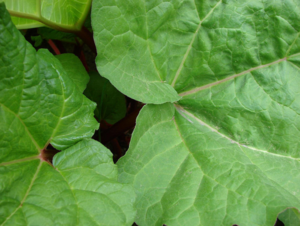
This page contains a selection of recipes of homemade pest control solutions. Homemade pest control solutions focus on using plants, soaps, spices, coffee grounds, mulches, etc., known to be able to control pests in the garden, safely and effectively. Such solutions can be of great benefit to gardeners and small-scale farmers, as many homemade pest control solutions can be made from locally available materials for little cost but with good effect. Such solutions can aid persons seeking to farm or grow plants organically (namely, without the use of conventional commercially-produced pesticides) and to those who are concerned about the effects of such products on the environment and on human health. For people who wish to use these homemade solutions, the aim is to avoid using manufactured products that frequently contain much harsher chemicals and synthetic products that can have health and safety concerns.
Note that in some countries, it may be considered illegal to make anything that passes for a "pesticide" at home, such as under EU regulations.[verification needed] This is something to be aware of, and to make your own assessment of, as is the fact that being prosecuted for spraying a plant with soapy water to kill some aphids would be a somewhat vexatious misuse of the law's intent to ensure safety.
Things to be aware of[edit | edit source]
- Always be aware of safety first. Any product intended for use on plants and gardens to eradicate pests should be handled with care, kept away from children, pets, etc. If you store any solutions, do so in containers that are well marked and are kept out of reach of anyone not likely to know what the product is intended for.
- Pest control solutions will also harm beneficial insects, so never use them in a broadsweeping way and only use them for the specific need as it arises, targeted solely to where the pest is found (or as instructed by the directions for use in the recipe).
- In some cases, insect pests may develop tolerance for the homemade solution as they might with commercially produced products. However, this depends on what the product is and how it is being used and does not apply to all solutions.
When making and using garden sprays[1][edit | edit source]
- Wear gloves to protect your skin from the active ingredients.
- Wear goggles to protect from spray reaching your eyes.
- Cover yourself fully with long-sleeved pants and shirts when spraying.
- Boil sprays in well-ventilated rooms, avoid inhaling fumes (consider wearing a mask) and never use the same containers for food that sprays have been made in. Label the containers and keep them separate from food ones. Use stainless steel and enamel saucepans for heating sprays.
Basic protection and maintenance[edit | edit source]
Aim to create conditions ideal for the plant and not the pest. This means knowing the optimal soil, watering and feeding conditions for the plants grown and making your best efforts to achieve this. In this way, the plants will be less stressed, stronger and better able to resist pest infestations.
- Remove leaves and stems damaged by pests and discard of properly.
- Where possible, remove the insects by hand, through squashing, hosing off or exposing in some way.
- Use sacrifice plants - allowing some plants to be the attacked ones, while others grow relatively unscathed.
Soap solutions[edit | edit source]
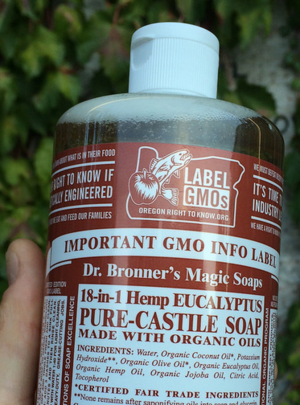
Aphid soap spray[2][edit | edit source]
Soap spray will clog the breathing holes of aphids.[2] It's an easy solution to make and use.
- Find a suitable sized container to mix the ingredients in. A glass or ceramic mixing bowl works well.
- Add 1 teaspoon of vegetable oil, 1 teaspoon of dish detergent and 1 cup of water to the bowl. Alternatively, add 3 tablespoons of liquid soap and a gallon of water. Stir to combine the recipe ingredients.
- Pour the mixture into a spray bottle.
- Use on affected plants. Spray the whole plant, focusing especially on the underside of leaves and stems. For this to be effective, it must contact the aphids.
- Leave for several hours. Wash from the plants after this, using a gentle stream from a garden hose. This protects the plants.
- Repeat as needed. You may need to keep applying this every few days until the aphid population is under control.
Spider mite dish detergent spray[2][edit | edit source]
- Find a suitable sized container to mix the ingredients in. A glass or ceramic mixing bowl works well.
- Add 3 tablespoons of dishwashing soap with 1 gallon of water in the mixing bowl. Stir to combine.
- Transfer to a spray bottle.
- Spray on the affected plants, wetting the leaves completely. Leave for a few hours to suffocate the spider mites, then wash the plants with a gentle hose spray.
- Reapply every 5 to 6 days.
Spider mite can also be sprayed with insecticidal soap.
See also the rhubarb spray solution below, which has pure soap added to it.
Further reading[edit | edit source]
Rubbing alcohol solutions[edit | edit source]
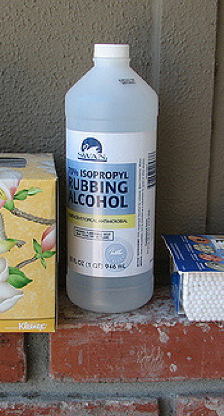
Aphid, spider mite and whitefly control[2][edit | edit source]
- Dip cotton balls into rubbing alcohol.
- Wipe the affected plants, leaves and stems, with the rubbing alcohol.
- Leave for a few hours, to kill off the pests.
- Wash the rubbing alcohol off the plant(s) with a garden hose.
Rhubarb leaves spray[edit | edit source]

This spray is an effective insecticide, as the leaves contain oxalic acid.[1]It is suitable for use on aphids, woolly aphids, horned and stink bugs, caterpillars, sawfly larvae, whitefly and leaf miner adults.[1]However, bear in mind that rhubarb leaves are toxic to humans too and must not be ingested. All care must be taken when storing this poisonous spray, including keeping it out of the reach of children and pets.
Rhubarb leaves spray #1[3][edit | edit source]
- Select 1 kilogram/2 pounds of rhubarb leaves in 2 litres/4 pints of water. Do not use an aluminum saucepan.
- Boil for about half an hour (30 minutes).
- Remove from the heat. Allow to cool completely.
- Strain the cooled liquid to remove the leaves. Pour into a suitable container, such as a large spray bottle.
- Add sufficient pure soap to create a frothy mixture. This helps the spray to stick.
- Label clearly. Place out of reach of children and pets in a dark, cool place.
- Use as needed. Spray on plants infested with non-beneficial insects, targeting those only.
Rhubarb leaves spray #2[1][edit | edit source]
- Pick 10 rhubarb leaves.
- Chop the leaves roughly. Add to a bucket or bowl.
- Boil sufficient water to cover the leaves. Pour the boiled water into the bucket with the chopped leaves, to cover. Cover with a lid, plate or other covering. Leave to cool.
- Strain out the leaves. Discard the leaves.
- Dilute the rhubarb leaf mixture. Add 1 litre of water to dilute the spray.
- Use as needed. This should be used within a few days of making it.
Quassia chips spray[1][edit | edit source]
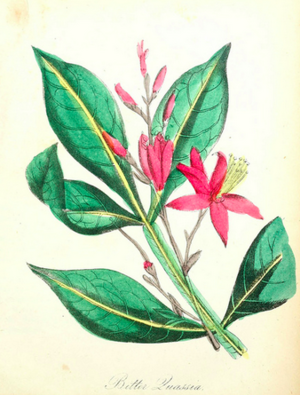
Quassia (Quassia amara) contains bitter chemicals quassin and neoquassin in its bark, wood and roots.[1]These chemicals are a mild insecticide that will target aphids, bugs, butterflies and moths, caterpillars, sawfly larvae, scale, spider mites and thrips.[1]
- Place 25g of quassia chips into 1 litre of water in a saucepan.
- Boil for half an hour.
- Remove from the heat. Strain out the quassia chips.
- Dilute with 3 parts water to 1 part quassia liquid before use. Pour the liquid into a spray bottle.
- Use with care. It has wide and potent effect, so be sure to use wisely.
Sodium bicarbonate spray (bicarbonate of soda, baking soda) or potassium bicarbonate[edit | edit source]
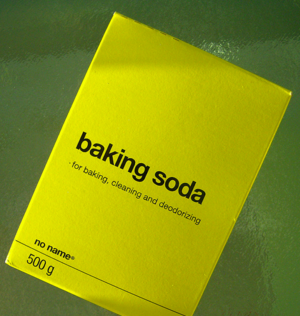
Sodium bicarbonate or potassium bicarbonate can control fungal problems in the garden.[1]It does so by changing the pH on the leaf surface, making it more alkaline.[1][4]At an pH of 8, fungus will stop growing.,ref name="Rosenthal" /> It can be used for blackspot, powdery mildew, downy mildew, rust on roses, grapevines and other plants.[1][4]
Note that while sodium bicarbonate is easy to reach for, it has drawbacks. It is not as effective as potassium bicarbonate and leaves sodium in the soil.[4]
Baking soda spray #1[1][edit | edit source]
- Place 2 teaspoons of bicarbonate of soda into a large container.
- Add a few drops of liquid vegetable-oil-based soap. Add 1 teaspoon of vegetable oil.
- Pour in 2 litres of water. Mix well to combine.
- Transfer to a liquid spray bottle. Shake well.
- Use as required. Shake well before each use. When using, spray both the top and underside of the leaves where the pests are, then repeat once a week to every three weeks, as needed to quell the pest problem.
Baking soda spray #2[4][edit | edit source]
- Place 1 teaspoon of baking soda into a spray bottle.
- Add a few drops of castile soap or a similar wetting agent.
- Pour in 1 pint (475ml) of water.
- Mix well to combine. Shake well before each use.
- Spray weekly on new growth.
Potassium bicarbonate spray[4][edit | edit source]
- Place 1 teaspoon (5ml) of potassium bicarbonate into a suitable container.
- Add 1 teaspoon of oil and a small amount of wetting agent to 1 pint (475ml) of water.
- Make a spray using one half of one percent, mixed in water.
Further reading[edit | edit source]
- http://web.archive.org/web/20110426022311/http://www.dirtdoctor.com/view_question.php?id=204
- http://www.flowerpotheaven.com/gardeningtips/2006/07/26/organic-pesticides-part-1/
Milk spray[edit | edit source]
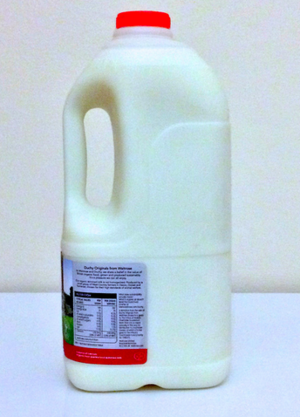
Milk is a useful deterrent against powdery mildew.[4]It can be used on roses and other plants, to ward off the powdery mildew.[4]
Milk spray #1[4][edit | edit source]
- Pour one part of milk into a spray bottle.
- Dilute with nine parts water.
- Shake to combine.
- Spray as required. Weekly spraying should keep the powdery mildew at bay.
Milk spray #2[edit | edit source]
- Pour 1/4 litre of fresh milk into 2 litres of water. Shake to combine.
- Transfer to a spray bottle.
- Spray as required.
Further reading[edit | edit source]
(Wood) ash[edit | edit source]
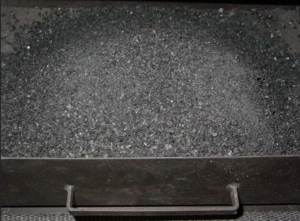
Wood ash is alkaline and therefore useful as a fungicide and a pesticide.[4]Insects that come into contact with wood ash are burned.[4]Use of wood ash dry or in a solution directly on plant leaves is not recommended.[4]
Wood ash recipe #1[4][edit | edit source]
- Obtain some wood ash.
- Place the wood ash around the plants to be protected. Be very careful to keep the wood ash at least 5cm or 2 inches away from the stem of the plant.
Chili/Chilli/Chile pepper spray[5][edit | edit source]

This insecticide is used to deter chewing insects.[5]
- Place 750ml of plain vinegar into a saucepan. Gently warm the vinegar.
- Grind 8 small dried chillies with 1 tablespoon of black pepper.
- Add the ground chillies and pepper with the warmed vinegar. Stir to combine.
- Remove from the heat. Leave to stand until it is fully cooled. Then transfer to a container with a lid and label with the name and date.
- Use when needed. This spray can be used on aphids, caterpillars and earwigs. Apply when the weather is dry and reapply regularly, as it only has short-term viability.
Garlic spray[5][edit | edit source]
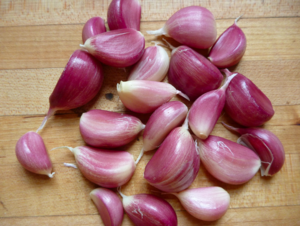
Garlic spray can be used to deter aphids, thrips and pear slugs.[5]
- Grate 25g of pure soap and place into 500ml of warm water. Leave it to dissolve into the water.
- Once the soap has dissolved, at 2 teaspoons of paraffin and 100g of crushed fresh garlic. Mix together.
- Set aside the mixture to infuse. Transfer to a container with a lid. Label with the name and date.
- Use when needed. Spray directly onto the pest, taking care to target only the pests. The paraffin content will help the spray to stay on the plant longer.
******** Under Research Still *********[edit | edit source]
NOTE: Everything in this section is undergoing research for revision and referencing. Do not rely on these until they have been properly researched and referenced. Comments offered here are guidance pointers to things that need to be clarified.
To do:
- beer traps for slugs
- using squashing, mulching, companion planting, etc. - role here? or link to reducing usage?
- remove links to non-trustworthy sources, & link-only sections
- http://stlucie.ifas.ufl.edu/pdfs/master_gardener/Home%20Remedies%20for%20Insect%20and%20Disease%20Control%20on%20Plants.pdf
Ethanol[edit | edit source]
See http://web.archive.org/web/20080821124420/http://wiwi.essortment.com/homemadeorgani_renu.htm
Ethanol-soap mixture : a hot water solution with 1 to 3% (10-30g/liter) soft soap (green or brown). Add 50 ml of ethanol per liter of water.
Cornmeal solution[edit | edit source]
Human/animal urine[edit | edit source]
(this recipe is for cow urine) Urine helps in plant growth as well as being an organic pesticide.( Used with beans)
- Add 1 litre to 2 litres of water.
- Spray.
Chinaberry[edit | edit source]
This recipe has been used successfully with beans. *** used "successfully" against what?***
- Pluck leaves.
- Dry in shade.
- Crush using crusher (or large stone).
- Put in water for 24 hours. Add 3 tablespoons to 1 litre of water.
- Strain the liquid and dilute it with a further 2 litres of water.
- Spray on leaves for protection.
Neem[edit | edit source]
This recipe has been used successfully with cowpeas. Follow the same process as for chinaberry (see above).
Paprika, hot pepper[edit | edit source]
- http://web.archive.org/web/20080821124420/http://wiwi.essortment.com/homemadeorgani_renu.htm
- http://www.motherearthnews.com/Organic_Gardening/1994_February_March/Guide_To_Organic_Pesticides
- http://www.howtopedia.org/en/How_to_Use_Chillies_as_a_Natural_Pesticide
Spearmint[edit | edit source]
Tomato Leaves[edit | edit source]
This recipe has been used successfully with tomatoes. It uses the indigenous tomato leaves (which presumably have more stronger/appropriate insecticidal properties than normal tomato leaves). ***"indigenous" tomato leaves? Indigenous to where? Which variety? What is a "normal" tomato leaf?***
- Leave in shade 2-3 days to dry.
- Crush.
- Add 6 tablespoons of powder to 3 litres of spray.
- Spray.
Tobacco[edit | edit source]
Materials needed:
- Dry tobacco leaves or fresh tobacco leaves ***The nicotine in the tobacco is a drug. Do you want to use this on something you're going to eat?***
- A piece of brown soap
- 1 cigarette
- Water
- A mortar for pounding
- A basin for mixing
- An old cloth for filtering
Procedure:
- Pound the dry leaves and fill 1 tumpeco with them.
- Mix these pounded leaves with 6-8 tumpecos of water.
- Add the content of one cigarette.
- Cover and leave the mixture for 7 days, or heat until almost boiling.
- Then add the equal amount of soapy water (i.e. 6-8 tumpecos).
- Filter the solution with an old cloth and apply by spraying.
OR:
- Pound the fresh leaves and fill 1 tumpeco with them.
- Mix these pounded leaves with 4-5 tumpecos of water.
- Cover and leave the mixture for 7 days, or heat until almost boiling.
- Then add 5 times the amount of soapy water (i.e. 20-25 tumpecos).
- Filter the solution with an old cloth and apply by spraying. Note that this is especially good against stem borers, mites, aphids, snails, beetles and worms.
- Other recipes:
External links[edit | edit source]
- [3]-poster on how to make an organic pesticide
Sources and citations[edit | edit source]
- ↑ 1.00 1.01 1.02 1.03 1.04 1.05 1.06 1.07 1.08 1.09 1.10 Penny Woodward. (2011) Pest Repellent Plants, ISBN 978-1-86447-118-2
- ↑ 2.0 2.1 2.2 2.3 http://extension.oregonstate.edu/gardening/node/1057
- ↑ Diana Anthony. (2012) The Ornamental Edible Garden, ISBN 978-1-86953-812-5
- ↑ 4.00 4.01 4.02 4.03 4.04 4.05 4.06 4.07 4.08 4.09 4.10 4.11 Ed Rosenthal. (2013) Ed Rosenthal's Protect Your Garden, ISBN 978-0-932551-19-1
- ↑ 5.0 5.1 5.2 5.3 Andrew Seccull. (2006) The Perfect Garden, ISBN 1-920989-27-7